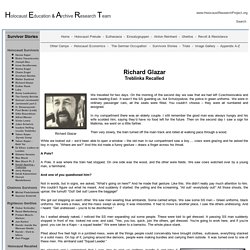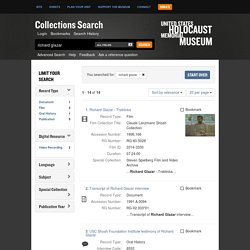

Neznámí hrdinové - Pohnuté osudy. Steven Spielberg Film and Video Archive. Title:Claude Lanzmann Shoah Collection, Interview with Richard Glazar Collection Title:Claude Lanzmann Shoah Collection Event Date:1978-1981 Place:Basel, Switzerland Copyright:US Holocaust Memorial Museum & Yad Vashem & State of Israel Duration:07:24:00 Links:Lanzmann's original transcriptEnglish translation of transcript by USHMM Description:***Clips that are viewable online are selected excerpts from the complete interview, which can be viewed at the Museum Richard Glazar, a survivor of Treblinka, is another individual featured prominently in Shoah.

FILM ID 3314 -- Camera Rolls #1-3 -- 01:00:03 to 01:34:05 CR1 Glazar sits on a couch in front of a window. 01:11:21 CR2 Glazar says that there was antisemitism in Czechoslovakia but he did not suffer from it. 01:22:50 CR3 Glazar describes saying goodbye to his parents on the telephone before they were deported. 02:11:23 CR5 Glazar says that Theresienstadt was not so bad for him. Richard Glazar Survivors Stories www.HolocaustResearchProject.org. We travelled for two days.

On the morning of the second day we saw that we had left Czechoslovakia and were heading East. It wasn’t the SS guarding us, but Schutzpolizei, the police in green uniforms. We were in ordinary passenger cars, all the seats were filled. You couldn’t choose – they were all numbered and assigned. In my compartment there was an elderly couple. Then very slowly, the train turned off the main track and rolled at walking pace through a wood. While we looked out – we’d been able to open a window – the old man in our compartment saw a boy…. cows were grazing and he asked the boy in signs, “Where are we?”
A Pole? A Pole. And one of you questioned him? Not in words, but in signs, we asked, “What’s going on here?” We got out stepping on each other. As I waited already naked, I noticed the SS men separating out some people. He shouted and I understood that I was also to pick up clothing, bundle it and take it somewhere. But it still hadn’t sunk in, I didn’t believe it. Why? USHMM Collections Search Search Results. Searching Entering terms in the main search box will return results where those terms occur anywhere in the record.

You may target your search to certain fields by changing the dropdown selection to the right of the 'Search' box from "All Fields. " Facets Use the "facets" to limit your searches. These are the links at the left under the "Limit your search" heading, with categories such as "Record Type," "Language," and "Online.
" Advanced Search An advanced search is available by clicking the link "More Options (Advanced Search)". Geographic Name Expansion Collections Search also embodies a "geographic name expansion" feature. Boolean Queries Collections Search supports boolean queries including AND, NOT, and OR (which must be uppercase) and parentheses. Richard Glazar: Treblinka, slovo jak z dětské říkanky (1/12) Treblinka (památník)Foto: Creative Commons Attribution-Share Alike 3.0 Poland On-line do neděle 7. června 2015.

Poslouchejte na Vltavě od 1. června 2015 vždy v 11:30. Po odvysílání se jednotlivé díly četby objeví také na stránce Hry a literatura. Zůstanou tam vždy po dobu jednoho týdne. Dnes již klasické dílo memoárové literatury zachycuje hrůzy nacistické genocidy Židů. Pro čtenáře jsou tyto paměti dokumentem, před nímž bledne každá románová fikce: autor jako ojedinělý svědek pekla vyhlazovacích táborů zachytil lidské dispozice ke zlu, ale i věčnou touhu člověka po svobodě. Richard Glazar (1920-1997) původem z Prahy a Kolína dospíval na sklonku 30. let a jelikož z rasových důvodů nemohl studovat, pracoval jako dělník. 2. srpna 1943 propuklo dlouho připravované povstání, jehož se zúčastnilo také šest českých a slovenských Židů. Glazar po válce vystudoval ekonomii, cizí jazyky, pracoval v zahraničním obchodu, ve Výzkumném ústavu výstavby a architektury a nakonec v ČSAV. Čte: Ivan Řezáč.